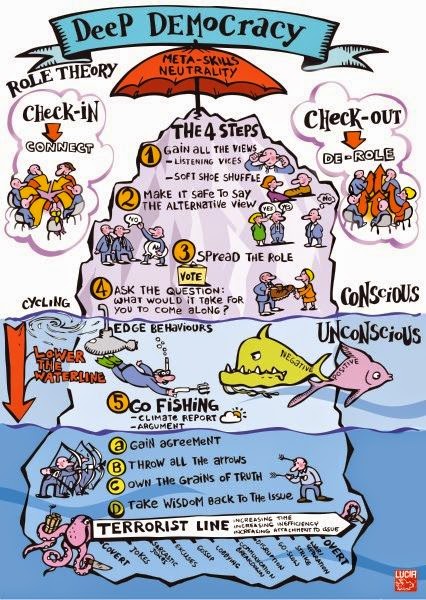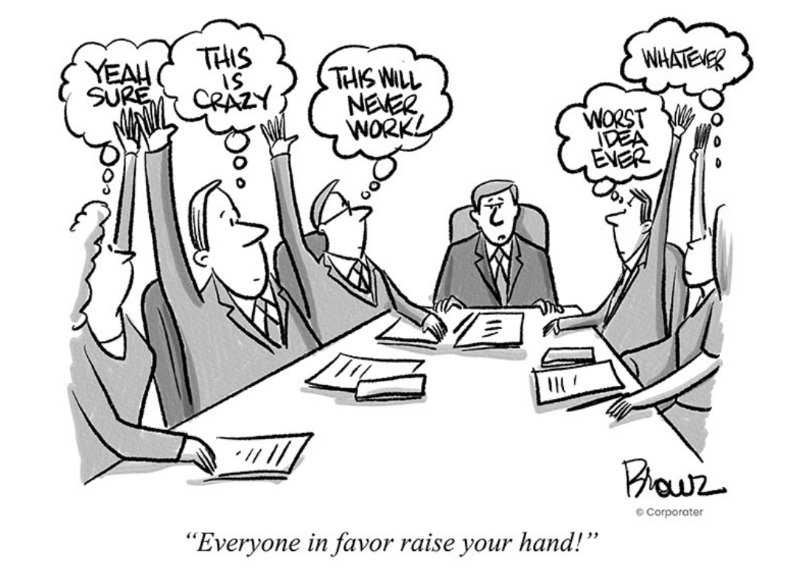Some unusual terms of Lewis Deep Democracy include, “spreading the no,” “sitting on your hands,” “listening for the li,” “role fludity, “edge behaviour,” “fish,”and “waterline.”As odd as they are, the system uses these terms to reach to the wisdom of the groups for consensual decision making and for being able to say everything that needs to be said.
Deep Democracy is a facilitation methodology that emphasizes inclusivity by ensuring that even unpopular views are considered. This approach is vital for conflict resolution, team dynamics, and community building. We use it on an individual level as well as on a group level like a department or a certain group in society. We also use it at a systemic level, such as for a national system.
What is Lewis Deep Democracy?
Lewis Deep Democracy is a world view with tools to go through conflict and tension. It ensures that all voices, including unpopular and hidden ones, are heard, making it possible to solve seemingly unsolvable problems. This innovative method helps manage group dynamics, make effective decisions, and resolve conflicts by valuing not only the majority’s but also the minority’s views for wiser decisions. As such, it enriches the group process by uncovering emotions, values, and beliefs beyond typical facilitation methods.
Deep Democracy is based on the work of psychologist and physicist Arnold Mindell as he has transformed Karl G Jung’s work into group psychology and group-oriented processes. Myrna Lewis, one of the founders of Lewis Deep Democracy, states, “Many of us want to avoid conflict at all costs. This is a contradiction. If we don’t resolve and engage in conflict, we actually lose our relationship.” Using this principle, she built upon the process work and created a mechanism where deep democracy can be used in any setting from private to public. Actually there are even subgroups of Lewis Deep Democracy of education, relationships and parenting in addition to its work at organisational change, social change and pre-post conflict in communities
The “Lewis Method,” as it is known, clarifies Mindell’s concepts and principles for group facilitation. The approach has been adapted to various programs, emphasizing individual empowerment, self-expression, and listening skills. Key themes include role theory, the resistance line, argument and debate methods, which are relevant in everyday life.
For more information and cases, visit the website Lewis Deep Democracy.

Tips and Advice for Fostering Inclusivity with Deep Democracy
- Create Safe Spaces. Ensure that participants feel safe to express their thoughts and feelings without fear of judgment or retribution. We can achieve this by setting ground rules and modeling respectful behavior. While modelling in LDD, the faiclitator of the check in speaks first during Check in and speaks last in check out, setting the tone. The facilitator tries to highly encourage participants not to agree or disagree with the comments during these rounds.
- Encourage Minority Voices. Actively seek out and encourage the participation of individuals whose voices are often marginalized. This can involve direct invitations or creating smaller group discussions. This constant lookout for “unpopular vie” or “No” is called “spreading the No. We try to own the parts that we ignore or do not listen to.
- Use the ‘No’ Exercise. This exercise helps groups explore and understand the resistance within the group. Participants express their disagreements, which the group then discusses openly. Use 5 steps for decision making.
- Facilitate Deep Listening. Train participants in deep listening techniques, where they focus entirely on understanding the speaker’s perspective without planning their response.
- Implement the ‘Check-In’ Process. Start meetings with a check-in process where each participant shares their current state, promoting openness and emotional safety.
- Utilize the ‘Hot Seat’ and PopocornTechnique. This technique involves one person sharing their view while others listen and ask questions to deepen understanding, rather than debate. There shouldn’t be an order of rounds for participants.
- Reflect on Group Dynamics. Regularly reflect on the group’s dynamics and power structures, making adjustments to ensure equitable participation. This is called “climate reporting”.
- Provide Training on Deep Democracy. For those in who are comfortable in the system, conduct training sessions on Deep Democracy. Sharing the techniques on 4 levels can equip participants with the necessary skills to facilitate inclusive discussions in their own organizations.
- Celebrate Differences. Pick tools for the group to see diversity as wisdom and celebrate the differences that each member brings to the table.
Implementing Deep Democracy can significantly enhance inclusivity and psychological safety within any group or organization. By valuing all voices, especially unpopular views, we can create richer, more empathetic, and wiser communities. For more information and resources, explore the recommendations provided and begin your journey towards a more inclusive practice today.

Recommendations for Further Learning
- Books :
The Deep Democracy of Open Forums by Arnold Mindell
Sitting in the Fire by Arnold Mindell
- Podcasts :
The Deep Democracy Podcast – explores real-life applications of Deep Democracy principles.
- Videos :
Deep Democracy in Action – YouTube series showcasing Deep Democracy techniques.
TED Talk: Myrna Lewis
Shiftbalance is committed to inclusive workspaces that are psychologically safe, and inclusive facilitation that goes beyond the surface. Browse our facilitation services and let us know how we can help!








